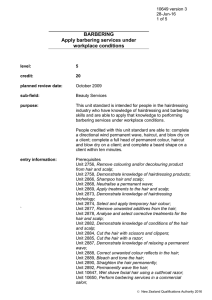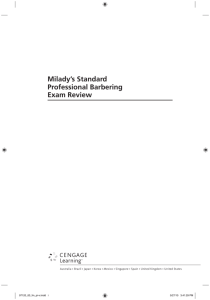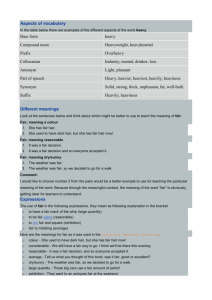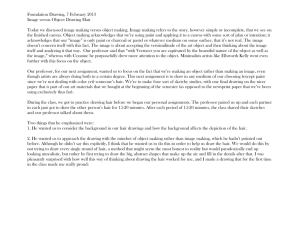curriculum for cosmetologist
advertisement
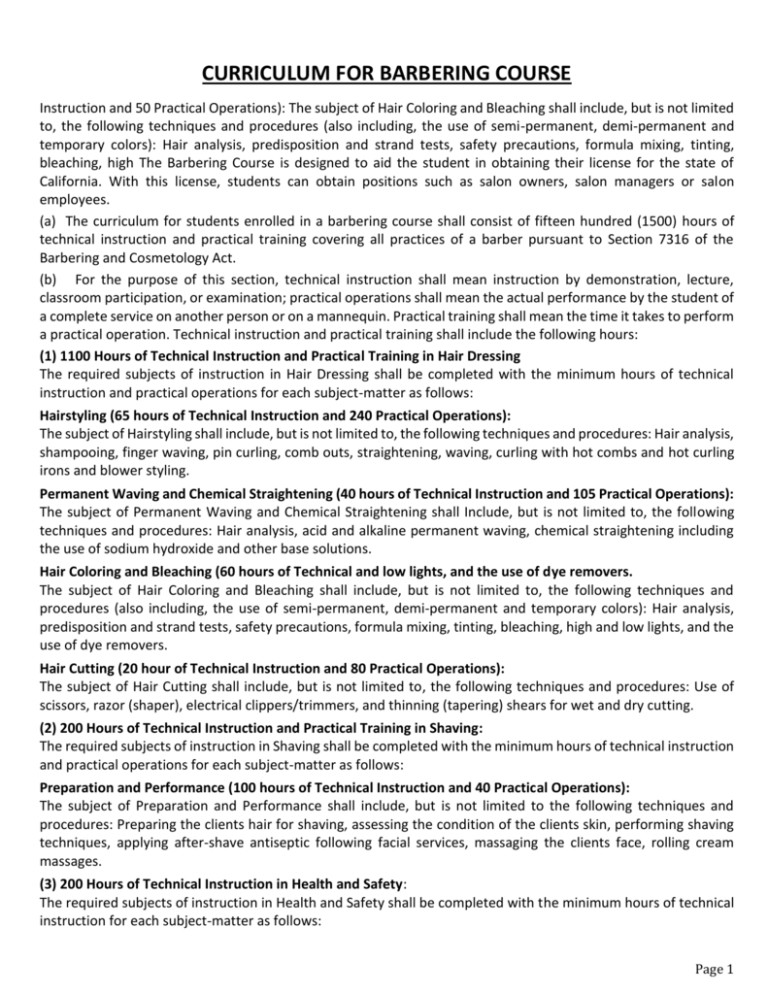
CURRICULUM FOR BARBERING COURSE Instruction and 50 Practical Operations): The subject of Hair Coloring and Bleaching shall include, but is not limited to, the following techniques and procedures (also including, the use of semi-permanent, demi-permanent and temporary colors): Hair analysis, predisposition and strand tests, safety precautions, formula mixing, tinting, bleaching, high The Barbering Course is designed to aid the student in obtaining their license for the state of California. With this license, students can obtain positions such as salon owners, salon managers or salon employees. (a) The curriculum for students enrolled in a barbering course shall consist of fifteen hundred (1500) hours of technical instruction and practical training covering all practices of a barber pursuant to Section 7316 of the Barbering and Cosmetology Act. (b) For the purpose of this section, technical instruction shall mean instruction by demonstration, lecture, classroom participation, or examination; practical operations shall mean the actual performance by the student of a complete service on another person or on a mannequin. Practical training shall mean the time it takes to perform a practical operation. Technical instruction and practical training shall include the following hours: (1) 1100 Hours of Technical Instruction and Practical Training in Hair Dressing The required subjects of instruction in Hair Dressing shall be completed with the minimum hours of technical instruction and practical operations for each subject-matter as follows: Hairstyling (65 hours of Technical Instruction and 240 Practical Operations): The subject of Hairstyling shall include, but is not limited to, the following techniques and procedures: Hair analysis, shampooing, finger waving, pin curling, comb outs, straightening, waving, curling with hot combs and hot curling irons and blower styling. Permanent Waving and Chemical Straightening (40 hours of Technical Instruction and 105 Practical Operations): The subject of Permanent Waving and Chemical Straightening shall Include, but is not limited to, the following techniques and procedures: Hair analysis, acid and alkaline permanent waving, chemical straightening including the use of sodium hydroxide and other base solutions. Hair Coloring and Bleaching (60 hours of Technical and low lights, and the use of dye removers. The subject of Hair Coloring and Bleaching shall include, but is not limited to, the following techniques and procedures (also including, the use of semi-permanent, demi-permanent and temporary colors): Hair analysis, predisposition and strand tests, safety precautions, formula mixing, tinting, bleaching, high and low lights, and the use of dye removers. Hair Cutting (20 hour of Technical Instruction and 80 Practical Operations): The subject of Hair Cutting shall include, but is not limited to, the following techniques and procedures: Use of scissors, razor (shaper), electrical clippers/trimmers, and thinning (tapering) shears for wet and dry cutting. (2) 200 Hours of Technical Instruction and Practical Training in Shaving: The required subjects of instruction in Shaving shall be completed with the minimum hours of technical instruction and practical operations for each subject-matter as follows: Preparation and Performance (100 hours of Technical Instruction and 40 Practical Operations): The subject of Preparation and Performance shall include, but is not limited to the following techniques and procedures: Preparing the clients hair for shaving, assessing the condition of the clients skin, performing shaving techniques, applying after-shave antiseptic following facial services, massaging the clients face, rolling cream massages. (3) 200 Hours of Technical Instruction in Health and Safety: The required subjects of instruction in Health and Safety shall be completed with the minimum hours of technical instruction for each subject-matter as follows: Page 1 CURRICULUM FOR BARBERING COURSE (Continued) Laws and Regulations (20 hours of Technical Instruction): The subjects of Laws and Regulations shall include, but is not limited to, the following issues: The Barbering and Cosmetology Act and the Board Rules and Regulations. Health and Safety Considerations (45 hours of Technical Instruction): Health and Safety/hazardous substances including training in chemicals and health in establishments, material safety data sheets, protection from hazardous chemicals and preventing chemical injuries, health and safety laws and agencies, bacteriology and preventing communicable diseases including HIV/AIDS and Hepatitis B. Disinfection and Sanitation (20 hours of Technical Instruction): The subject of Disinfection and Sanitation shall include, but is not limited to the following techniques and procedures: Disinfection and sanitation including proper procedures to protect the health and safety of the consumer as well as the technician, proper disinfection procedures for equipment used in establishments. Disinfection shall be emphasized throughout the entire training period and must be performed before use of all instruments and equipment. Anatomy and Physiology (15 hours of Technical Instruction): The subjects of Anatomy and Physiology shall include, but is not limited to the following issues: Human Anatomy, Human Physiology. (c) The Board recommends that schools provide training in the area of communication skills that includes professional ethics, salesmanship, client record-keeping, decorum, basic tax information relating to booth renters, independent contractors, employees, and employers. Note: Authority cited: Section 7312 and 7362(b), Business and Professions Code. Reference: Sections 7316, 7321.5(d)(1), 7362.5(a) and 7389, Business and Professions Code. BARBERING PERFORMANCE OBJECTIVE Acquire the required knowledge of laws and rules regulating California’s Cosmetology Establishments’ Practices. Acquire the required knowledge of sanitation and sterilization as related to all phases of hair and skin. Acquire the required knowledge of general theory relative to barbering including anatomy, physiology, chemistry, and theory. Acquire business management techniques common to barbering. SKILLS TO BE DEVELOPED Learn the relative process and procedures of implementing all barbering services. Acquire the knowledge of analyzing the scalp, face, and skin prior to all or any services to determine any disorders. Will learn the procedures and terminology used in performing all barbering services. Will learn the different techniques of shaving. PLEASE NOTE: Each student MUST maintain a (70%) or “C” average to maintain a satisfactory academic status. (See page 9-10 for the grading system.) Grading System: Superior Performance Above Average Minimum Academic Status --------> Average Unsatisfactory Failing 100% - 90% 89% - 80% 79% - 70% 69% - 60% 59% - Below =A =B =C =D =F Page 2




